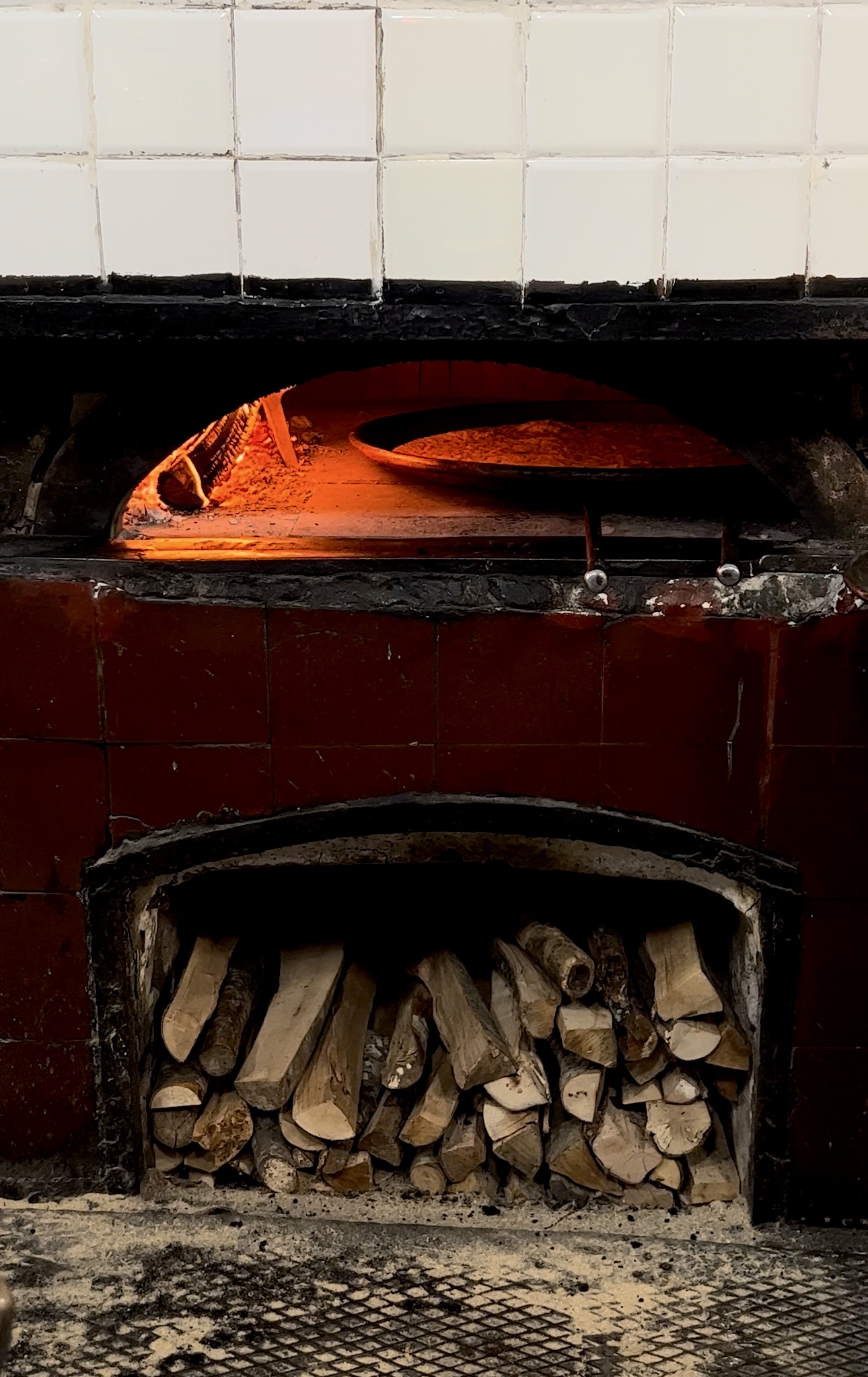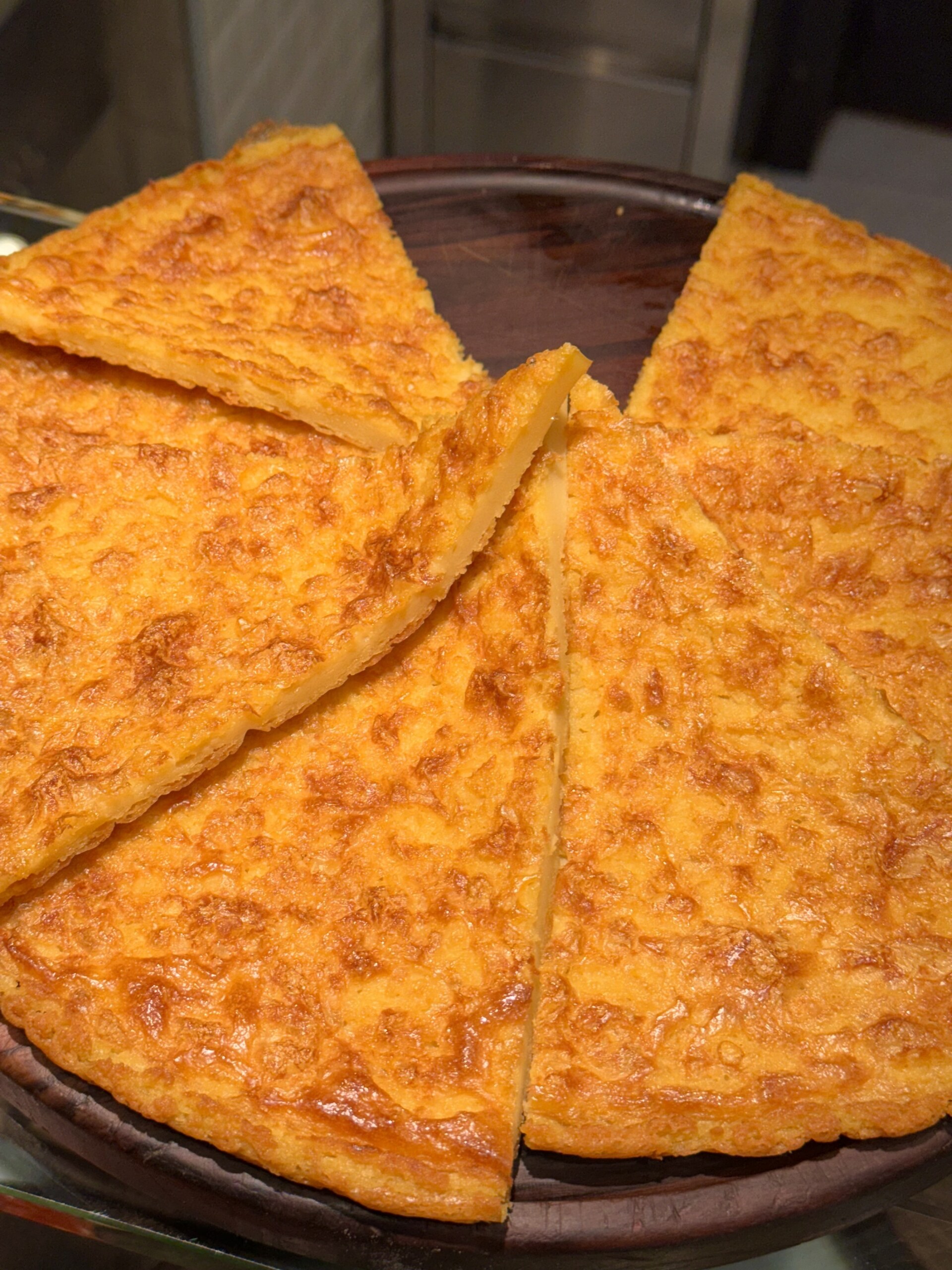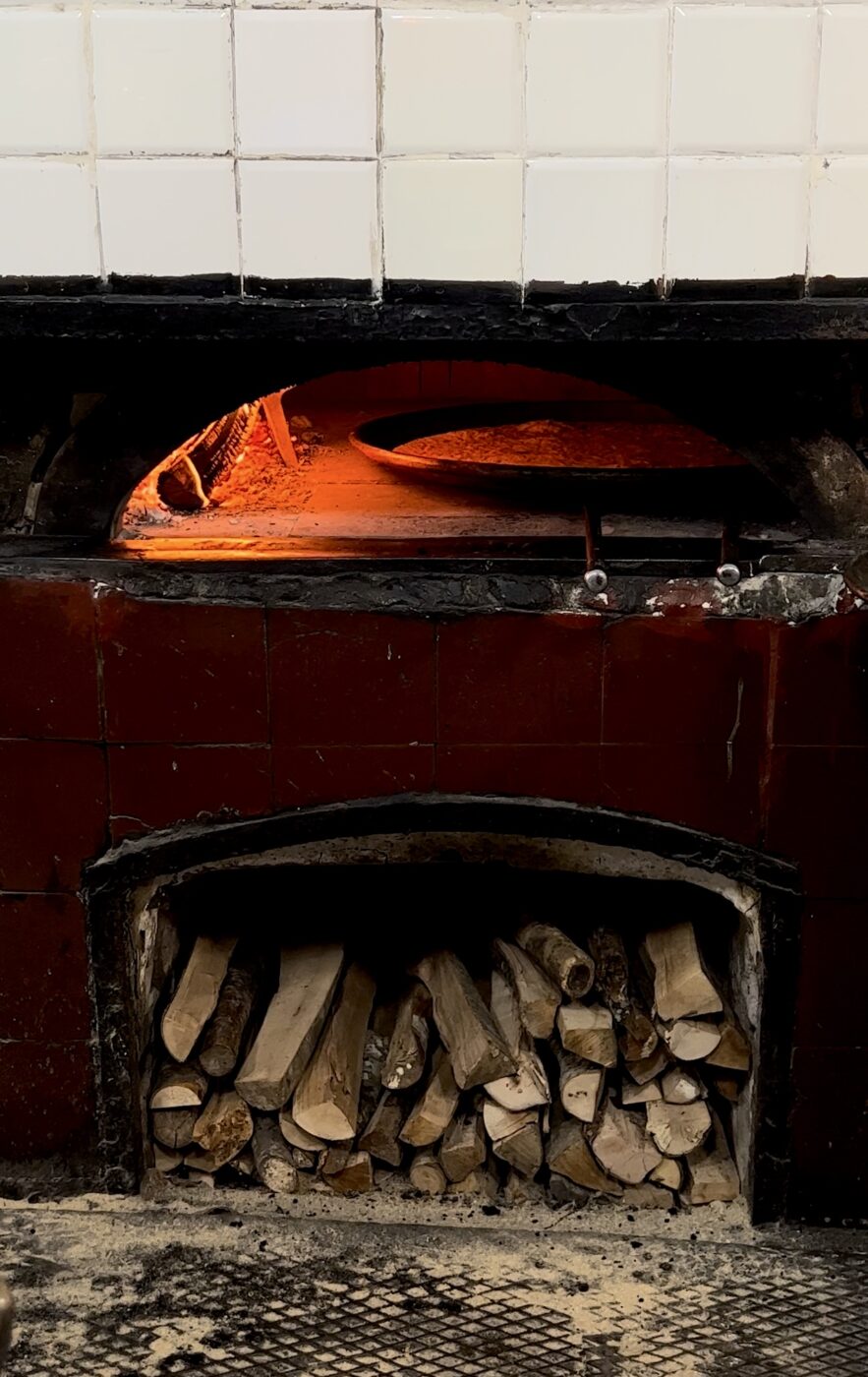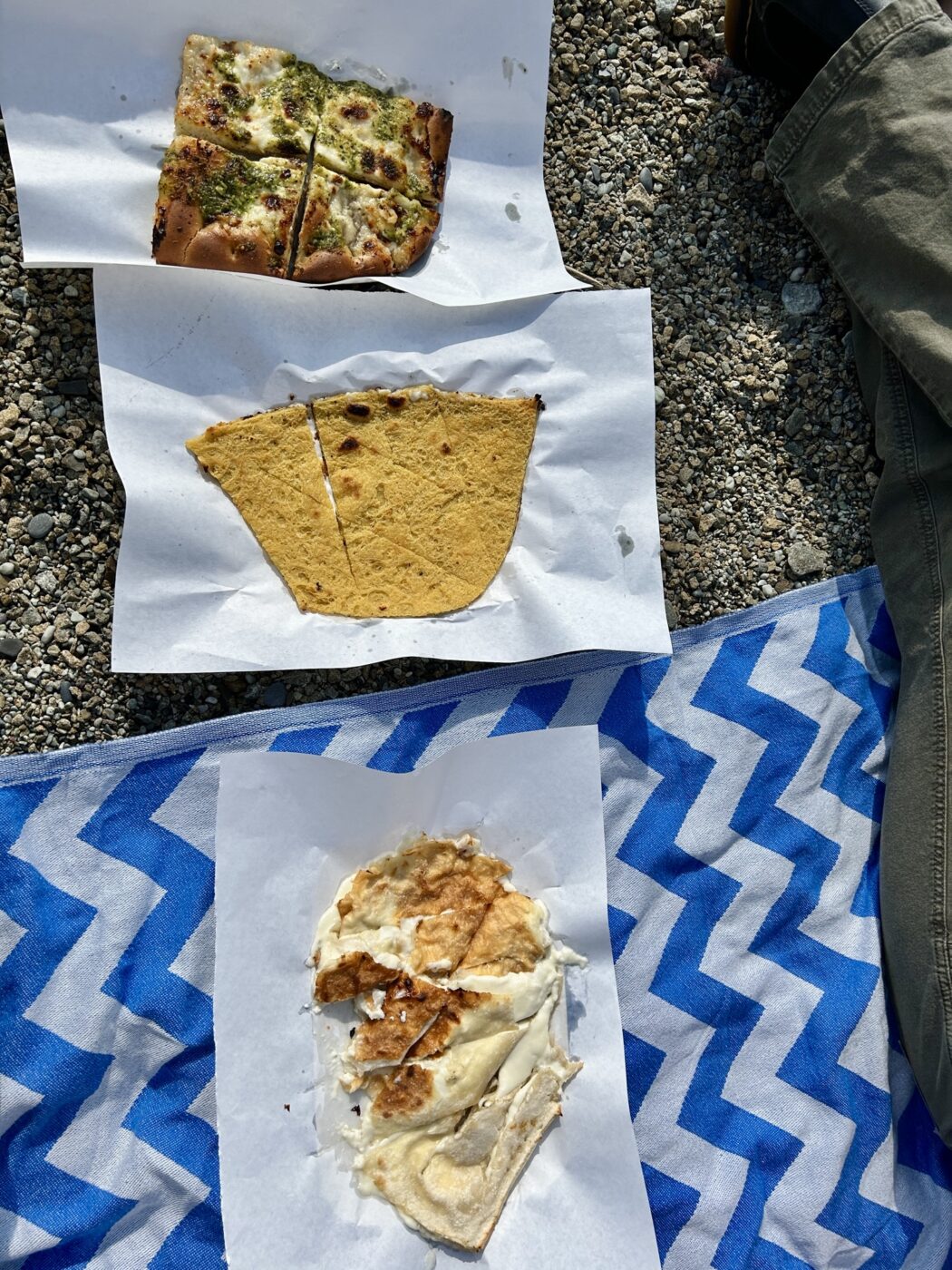While many (many!) come to Italy for the well-known wheat-based favorites like pizza and pasta, Liguria has a rich culture of non-wheat-based foods, the topography of the region being particularly inhospitable to growing the grain. Here, rather, you’ll find chestnuts milled into flour and rolled into tagliatelle, delicious with funghi, and, most importantly, chickpeas in the form of panisse (fried chickpea flour sticks, eaten as a snack with a simple salt and pepper topping) and farinata, a large chickpea flour flatbread that’s most often eaten as a street food.
I, a gluten-intolerant girly, come from an Abbrusezze family that loves their pasta with ragù, wood-oven pizza, and taralli, all very much made with wheat flour. I put my stomach through it because the food is just so damn good, but eating carbs without feeling sluggish and bloated has not been my past experience with Italy. But it’s another story here on the coast of Liguria.
Farinata–made with just chickpea flour, water, olive oil, and salt–has a similar consistency to roti bread and is cooked in a copper pan inside a wood oven. Crisp and golden on the top, soft and moist on the inside, glistening with olive oil… you can eat it plain or with toppings like cod, pesto, or grated Pecorino Romano. Every so often, you’ll find some with fillings.
Similar versions of the flatbread can be found all along this coast, from the socca of Nice, France, to Tuscany, where, in Massa and Carrara, it’s called “calda calda” (meaning “hot hot”) and farther south it’s known as cecina or torta di ceci.
I first came across farinata in Savona, a Ligurian port city that’s as unassuming as they come–but is filled with surprises like its underground music scene and late-night food options. Here, groups of teens sit on street corners tearing bits of it out of oil-soaked paper bags, while others snag tables at restaurants where different types of farinata are propped up on stands like big pizzas and cut into tiny little squares. Though the stuff may be omnipresent in Savona today, it was not always so–for Genova, you’ll find, has had a history of gatekeeping this beloved chickpea pancake.
1264-ish
Our story starts in the 13th century, when the Genovese have just conquered the Pisans in the Meloria battle (Pisa, like Genova, was a Maritime Republic and was one of Genova’s main rivals for the dominance over Corsica and Sardinia).
Legend has it that on their way back from battle, the Genovese fleet got stuck in a storm. The bags of chickpea flour on board fell and split across the deck, mixing in with the sea water that was crashing onboard. When the storm calmed, the sailors, fatigued and starving, recovered the batter–which would’ve had a dough-like consistency–and put it in the sun to dry. The next day, they were pleased to discover that it actually tasted delicious.
Upon arrival home, the seamen shared their culinary discovery and refined the recipe, baking it in wood ovens and adding salt to replace the sea water. In defiance over their enemy, they called it “the gold of Pisa”.
As is with Italian history–when it comes to food, politics, and money–the facts are a little blurry. Other forms of farinata have been said to date back to Roman times in Pisa: Mario Muda writes in his book La Savona della Farinata: Loughi, persone, storie that “the recipe for cooking Farinata was born in Pisa” and that “the poet Homer claims to see Ulysses as the inventor of farinata, during the epic siege of Troy”, though he also states that “there is no certain information on the Mediterranean area where this dish was invented or on the period in which it became popular.”
However, the Genovese sailor version is, by all accounts, the most common story of the dish’s inception.

1528-ish
From the 16th until the 18th century, Genova was pretty damn powerful as one of the main trading ports for both inland Italy and other Mediterranean territories. Alongside Venice, Genova’s commercial and maritime power grew and grew, supplying ships and sailors with goods for service, including food and machinery. Per this thesis for the University of Genova, about 30% of the total tonnage of merchant vessels in the Mediterranean stopped in the port of Genoa in the first half of the sixteenth century.
At this time, Genoa was the capital of an oligarchic Republic, ruled by an elite of patricians actively involved in maritime trade, shipping, international finance, and credit. The port’s administration and functioning played a fundamental role in their economic policies, and when love for farinata spread along the coast, the Genovese felt their market was threatened–and were furious that their neighbors were copying their then-famous dish.
There are no official documents or recordings (very Italian), however it’s said that in 1528, Genova imposed high tariffs on chickpea flour for all cities outside of their own. This wasn’t uncommon for the times–imposing a high tax on a food item that had great significance to a place–as recipes, ingredients, and processes were a matter of pride and seen to be of great economic value in the 16th century. Whether it really was just a question of ego, or the fact that they were able to feed people affordably and make good money off the chickpea flour trade, is still up for debate.
Nearby Savona, however, had gotten a taste for farinata, but, no longer able to afford the high price of the legumes, countered by swapping the chickpea flour for white wheat flour. Still found on menus today, farinata bianca (white farinata) is more bread-like, a little thicker, and similar to focaccia, with a texture that’s spongier than chickpea farinata; it tastes like a really spring-y pizza base and is topped with all the same things as the chickpea flour version.
The stuff is common at large traditional festivities, such as the Good Friday Procession, Santa Lucia Fair, and at the start of Christmas celebrations.

Today
Today, there are no wild taxes on chickpeas–you can find them pretty much anywhere–but the pride of past history remains. This means that in Genova–where the original farinata was cooked in wood ovens with salt, water, and olive oil–you can only really find the chickpea flour version. But in Savona and neighboring towns, look for “white” or wheat flour farinata as well. The necessity of creating their own version has stuck–and us Italians are stubborn creatures. They took the time to replicate something they couldn’t have, and they won’t simply discard it for the sake of a modern world.
Where to Eat Farinata in Genova & Savona
Antica Osteria di Vido Palla (Genova) – This historic joint has its origins in the 1500s when sailors and poets passed through the streets of the ancient port, stopping to eat stockfish and other baked goodies. The simple interior tells this story of Ligurian tradition, and the bare-bones aesthetic applies to their typical Genovese menu.
Sà Pesta (Genova) – A large counter at the entrance to this three-generation family spot is filled with huge rounds of farinata and pies that get cooked in the wood-fired oven right behind. Amongst the white tiles, wooden benches, house wine by the liter, and piles of pasta with pesto and salsa di noci, the Benvenuto family continues the legacy of the tortaio, or “pie maker,” a traditional occupation in Genova that dates back to the Middle Ages. Come by for lunch, dinner, or a quick snack.
Antica Sciamadda (Genova) – One of the city’s oldest street food establishments, vintage rustic copper pans speak to the bakery’s, and Genova’s, history of making focaccia, torte salate, and farinata. Here, their wood-fired ovens burn from morning until night, and you can stop by anytime for a piece of the aforementioned baked snacks.
Veximà (Genova) – Veximà was the nickname for this restaurant’s founder, the great-grandfather of current owners Stefano and Adele. Here, they’ve perfected the art of farinata, which remains the only thing fired up in their wood ovens. You’ll find it topped with fish, mushrooms, onions, and maybe some octopus and potatoes to call attention to the typical Ponente dish. Over 100 years and five generations later, Veximà is still a point of reference for the chickpea flatbread, consistently filled with locals crowding into the convivial historic tavern.
Vino e Farinata (Savona) – Come here for a large range of farinata styles, all traditionally made. Their original, with salt and oil, is excellent, but don’t miss the ones topped with pesto or cheese, or the farinata bianca, made with wheat.







